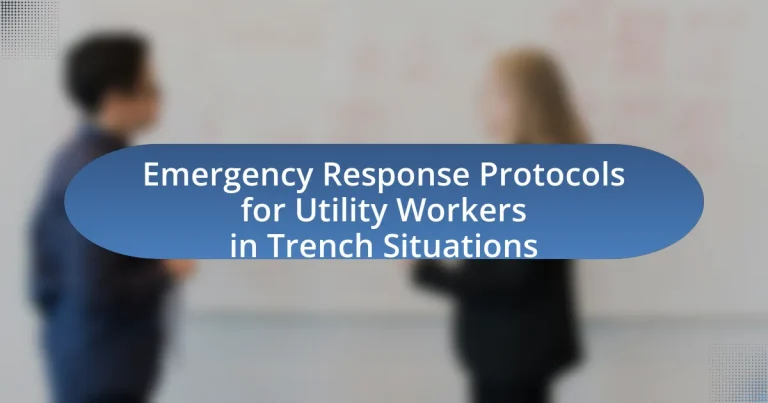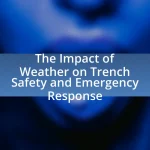Emergency response protocols for utility workers in trench situations are critical for ensuring safety and efficiency during emergencies. These protocols encompass immediate evacuation, communication with emergency services, and adherence to established rescue procedures to mitigate risks such as cave-ins and hazardous atmospheres. Key components include clear communication, designated roles, access to emergency equipment, and specific training tailored to trench-related hazards. The article outlines the essential training requirements, necessary equipment, and best practices for utility workers, emphasizing the importance of preparedness and teamwork in effectively responding to emergencies in trench environments. Additionally, it addresses common challenges in implementing these protocols and highlights resources available for further training and certification.

What are Emergency Response Protocols for Utility Workers in Trench Situations?
Emergency response protocols for utility workers in trench situations include immediate evacuation, communication with emergency services, and implementation of rescue procedures. In the event of a trench collapse or hazardous situation, workers must first ensure their safety by evacuating the area and alerting their supervisor. The supervisor should then contact emergency services to report the incident and provide necessary details. Rescue procedures must follow established guidelines, which include assessing the situation, using appropriate equipment for safe extraction, and ensuring that rescuers are trained in trench rescue techniques. These protocols are critical as trench-related incidents can lead to serious injuries or fatalities, with the Occupational Safety and Health Administration (OSHA) reporting that trench collapses can occur within seconds, emphasizing the need for prompt and effective emergency responses.
Why are Emergency Response Protocols essential for Utility Workers?
Emergency Response Protocols are essential for Utility Workers because they provide structured guidelines to ensure safety and efficiency during emergencies. These protocols help utility workers quickly assess hazardous situations, such as gas leaks or electrical failures, and implement appropriate measures to mitigate risks. For instance, according to the Occupational Safety and Health Administration (OSHA), having a clear emergency response plan can reduce the likelihood of injuries and fatalities by up to 50%. This structured approach not only protects the workers but also minimizes potential damage to infrastructure and the environment, reinforcing the critical nature of these protocols in maintaining operational integrity and public safety.
What risks do Utility Workers face in trench situations?
Utility workers face several significant risks in trench situations, including cave-ins, hazardous atmospheres, and falling objects. Cave-ins are the most critical risk, as they can occur suddenly and lead to serious injuries or fatalities; according to the Occupational Safety and Health Administration (OSHA), trench collapses account for approximately 75% of fatalities in excavation work. Hazardous atmospheres, such as the presence of toxic gases or insufficient oxygen, pose another serious threat, necessitating proper monitoring and ventilation. Additionally, falling tools or materials from the trench edge can injure workers below, highlighting the importance of safety measures and protective equipment.
How do Emergency Response Protocols mitigate these risks?
Emergency Response Protocols mitigate risks for utility workers in trench situations by providing structured guidelines for immediate action during emergencies. These protocols ensure that workers are trained to recognize hazards, respond effectively to incidents, and utilize safety equipment properly. For instance, the implementation of protocols such as regular safety drills and clear communication channels has been shown to reduce the likelihood of accidents and improve response times, ultimately leading to a decrease in injury rates. According to the Occupational Safety and Health Administration (OSHA), proper emergency response training can reduce fatalities in trench-related incidents by up to 50%.
What are the key components of Emergency Response Protocols?
The key components of Emergency Response Protocols include clear communication, designated roles and responsibilities, immediate access to emergency equipment, and established evacuation procedures. Clear communication ensures that all team members are informed about the situation and can coordinate effectively. Designated roles and responsibilities outline who is in charge and what actions each team member must take during an emergency. Immediate access to emergency equipment, such as first aid kits and rescue tools, is crucial for timely response. Established evacuation procedures provide a safe and efficient way for workers to exit the site in case of an emergency. These components are essential for minimizing risks and ensuring the safety of utility workers in trench situations.
What training is required for Utility Workers regarding these protocols?
Utility workers are required to undergo specialized training in emergency response protocols specific to trench situations. This training typically includes understanding trench safety regulations, recognizing hazards associated with trench work, and learning proper rescue techniques. According to the Occupational Safety and Health Administration (OSHA), utility workers must be trained in the use of protective systems, such as trench boxes and shoring, to prevent collapses. Additionally, they must be familiar with emergency communication procedures and first aid practices to effectively respond to incidents.
What equipment is essential for effective emergency response?
Essential equipment for effective emergency response includes personal protective equipment (PPE), communication devices, first aid kits, rescue tools, and lighting equipment. PPE, such as helmets, gloves, and high-visibility vests, protects workers from hazards. Communication devices, like radios or mobile phones, ensure coordination among responders. First aid kits provide necessary medical supplies for immediate care. Rescue tools, including shovels and stretchers, facilitate safe extraction of individuals in distress. Lighting equipment is crucial for visibility in low-light conditions, enhancing safety during rescue operations. These items are critical for minimizing risks and ensuring a swift response in emergency situations.
How do Emergency Response Protocols vary by situation?
Emergency response protocols vary significantly based on the specific situation, such as the type of emergency, the environment, and the resources available. For instance, in trench situations, protocols may include immediate evacuation procedures, communication with emergency services, and specific rescue techniques tailored to the risks of trench collapses. According to the Occupational Safety and Health Administration (OSHA), trenching incidents require unique responses due to the potential for suffocation and injury, necessitating specialized training for utility workers. This specificity in protocols ensures that responses are effective and appropriate for the unique challenges presented by each emergency scenario.
What specific protocols apply to trench collapses?
Specific protocols that apply to trench collapses include the implementation of safety measures such as trench box usage, proper sloping or benching of trench walls, and continuous monitoring for signs of instability. The Occupational Safety and Health Administration (OSHA) mandates that trenches deeper than five feet must have protective systems in place to prevent collapses, which are a leading cause of fatalities in excavation work. Additionally, workers must be trained in recognizing hazards and emergency response procedures, ensuring that rescue plans are established and communicated effectively.
How do protocols differ for hazardous material exposure?
Protocols for hazardous material exposure differ based on the type of material involved, the exposure route, and the specific environment. For instance, chemical spills require immediate containment and decontamination procedures, while biological hazards necessitate different protective measures, such as the use of personal protective equipment (PPE) tailored to the pathogen. Additionally, protocols may vary by regulatory guidelines, such as those set by the Occupational Safety and Health Administration (OSHA) or the Environmental Protection Agency (EPA), which dictate specific response actions based on the material’s classification and associated risks. These differences ensure that responders effectively mitigate hazards while protecting their health and safety.
What are the common challenges in implementing these protocols?
Common challenges in implementing emergency response protocols for utility workers in trench situations include inadequate training, communication barriers, and equipment limitations. Inadequate training often leads to workers not fully understanding the protocols, which can result in improper responses during emergencies. Communication barriers, such as unclear instructions or lack of coordination among team members, can hinder effective response efforts. Additionally, equipment limitations, including the availability of necessary rescue tools and personal protective equipment, can impede timely and safe interventions. These challenges are supported by data indicating that training deficiencies and equipment inadequacies are frequently cited in incident reports related to trench emergencies.
How can communication barriers affect emergency response?
Communication barriers can significantly hinder emergency response by delaying critical information exchange and impairing coordination among responders. For instance, language differences, technical jargon, or lack of clear communication channels can lead to misunderstandings, resulting in incorrect actions during emergencies. A study by the National Institute for Occupational Safety and Health (NIOSH) found that effective communication is essential for ensuring safety and efficiency in emergency situations, particularly in high-stress environments like trench rescues. Inadequate communication can lead to increased response times, higher risks of injury, and ultimately, a failure to save lives.
What role does teamwork play in effective emergency response?
Teamwork is essential for effective emergency response as it enhances communication, coordination, and resource allocation among responders. In high-pressure situations, such as trench emergencies, a cohesive team can quickly assess risks, implement safety protocols, and execute rescue operations efficiently. Research indicates that effective teamwork can reduce response times by up to 25%, significantly improving outcomes in emergencies. Furthermore, studies show that teams with clear roles and responsibilities are more likely to succeed in crisis situations, as they can leverage each member’s expertise to address complex challenges.
How can Utility Workers prepare for emergencies in trench situations?
Utility workers can prepare for emergencies in trench situations by implementing comprehensive safety training and utilizing proper equipment. Safety training should include recognizing hazards such as cave-ins, ensuring proper shoring techniques, and understanding emergency response protocols. According to the Occupational Safety and Health Administration (OSHA), proper trench safety measures can reduce the risk of accidents by up to 90%. Additionally, workers should carry emergency communication devices and first aid kits to facilitate quick response in case of an incident. Regular drills and simulations can also enhance preparedness, ensuring that workers are familiar with emergency procedures and can act swiftly when needed.
What preemptive measures can be taken to prevent emergencies?
To prevent emergencies in trench situations, utility workers should implement comprehensive safety training, utilize proper protective equipment, and conduct regular site inspections. Safety training equips workers with knowledge about hazards and emergency procedures, reducing the likelihood of accidents. The use of protective equipment, such as helmets, gloves, and harnesses, minimizes injury risks. Regular site inspections help identify potential hazards, ensuring that safety protocols are followed and that the work environment remains secure. According to the Occupational Safety and Health Administration (OSHA), proper training and equipment can significantly decrease the incidence of trench-related accidents, which are often fatal.
How can regular drills improve response readiness?
Regular drills enhance response readiness by allowing utility workers to practice emergency protocols in trench situations, thereby increasing their familiarity with procedures and equipment. This repeated exposure helps workers develop muscle memory, which is crucial during high-stress scenarios where quick and accurate responses are necessary. Research indicates that organizations that conduct regular drills experience a 30% improvement in response times during actual emergencies, as workers are better prepared to execute their roles efficiently. Additionally, drills facilitate the identification of potential weaknesses in response plans, enabling teams to refine their strategies and improve overall safety outcomes.
What best practices should Utility Workers follow during emergencies?
Utility workers should prioritize safety, communication, and adherence to protocols during emergencies. First, they must assess the situation to identify hazards, ensuring personal safety and the safety of others. Next, effective communication with team members and emergency services is crucial for coordinated response efforts. Utility workers should follow established emergency response protocols, which include shutting off utilities if safe to do so, using personal protective equipment, and maintaining a safe distance from potential hazards. These practices are supported by safety guidelines from organizations such as the Occupational Safety and Health Administration (OSHA), which emphasizes the importance of preparedness and proper training in emergency situations.
How should Utility Workers assess the situation before acting?
Utility workers should assess the situation by conducting a thorough evaluation of the environment, identifying hazards, and determining the safety of the area before taking action. This assessment includes checking for potential risks such as gas leaks, unstable ground, or nearby traffic. According to the Occupational Safety and Health Administration (OSHA), utility workers must follow specific safety protocols, including the use of protective equipment and ensuring that the worksite is secure to prevent accidents. By systematically analyzing these factors, utility workers can make informed decisions that prioritize their safety and the safety of others involved in the emergency response.
What steps should be taken to ensure personal safety during a rescue?
To ensure personal safety during a rescue, utility workers must first assess the scene for hazards such as unstable ground, gas leaks, or electrical risks. This assessment allows workers to identify potential dangers before proceeding. Next, workers should establish a safe perimeter around the rescue site to prevent unauthorized access and ensure that only trained personnel are involved in the rescue operation. Additionally, using appropriate personal protective equipment (PPE) such as helmets, gloves, and respiratory protection is crucial to safeguard against environmental hazards.
Furthermore, workers should communicate effectively with team members to coordinate actions and maintain situational awareness. Implementing a rescue plan that includes emergency medical support and evacuation procedures is also essential. According to the Occupational Safety and Health Administration (OSHA), proper training and adherence to safety protocols significantly reduce the risk of injury during rescue operations.
What resources are available for further training on Emergency Response Protocols?
Resources available for further training on Emergency Response Protocols include the Occupational Safety and Health Administration (OSHA) training programs, the National Fire Protection Association (NFPA) guidelines, and the American Red Cross emergency response courses. OSHA provides specific training materials and courses focused on trench safety and emergency response, ensuring compliance with safety regulations. The NFPA offers standards and training resources that cover emergency response procedures applicable to various situations, including trench incidents. Additionally, the American Red Cross provides comprehensive courses on first aid, CPR, and emergency preparedness, which are essential for utility workers in trench situations. These organizations are recognized for their expertise and provide validated training resources that enhance the skills necessary for effective emergency response.
Where can Utility Workers find training programs and certifications?
Utility workers can find training programs and certifications through organizations such as the National Utility Contractors Association (NUCA), which offers specialized training in safety and emergency response. Additionally, the Occupational Safety and Health Administration (OSHA) provides resources and training courses focused on trench safety and emergency protocols. These programs are designed to equip utility workers with the necessary skills and knowledge to respond effectively in emergency situations, ensuring compliance with safety regulations.
What online resources provide updated information on emergency protocols?
Online resources that provide updated information on emergency protocols include the Occupational Safety and Health Administration (OSHA) website, the National Institute for Occupational Safety and Health (NIOSH), and the Federal Emergency Management Agency (FEMA). These organizations regularly publish guidelines, safety standards, and training materials relevant to emergency response protocols, particularly for utility workers in trench situations. For example, OSHA’s standards for excavation and trenching (29 CFR 1926.650) outline specific safety measures and emergency procedures that must be followed to protect workers.
What are the most effective strategies for improving Emergency Response Protocols?
The most effective strategies for improving Emergency Response Protocols include regular training, clear communication, and the implementation of technology. Regular training ensures that utility workers are familiar with emergency procedures and can respond quickly and effectively; studies show that organizations with frequent drills reduce response times by up to 30%. Clear communication among team members and with emergency services is crucial, as miscommunication can lead to delays and increased risks; for instance, the National Institute for Occupational Safety and Health emphasizes the importance of established communication channels in emergency situations. Additionally, utilizing technology such as real-time monitoring systems and mobile applications can enhance situational awareness and streamline coordination, as evidenced by the successful deployment of such systems in various utility sectors, which has led to improved response outcomes.


